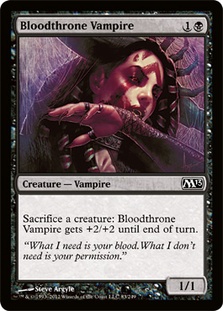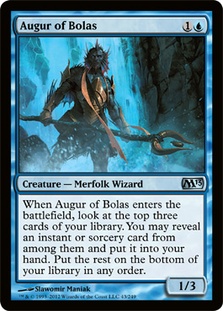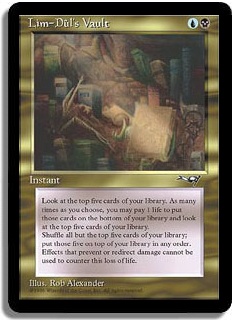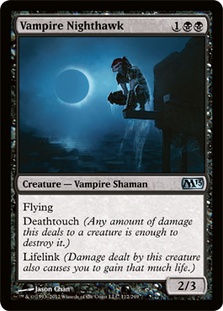This weekend featured three Grand Prix in three different formats as well as the StarCityGames.com Open Series: Las Vegas. I’m going to go over the results share my thoughts on each of these events.
Standard
The Top 4 of SCG Open Series: Las Vegas was half B/R Zombies and half U/W Delver. The Zombies decks look like they shared a point of origin, since they had very similar spells and curves with several points of disagreement where they played different cards in similar slots (like two Porcelain Legionnaires over two Highborn Ghouls and Geth’s Verdict over a third Tragic Slip). But they were basically the same deck in first and third with another, quite different, Zombies deck in the Top 8.
I expected Bloodthrone Vampire to be responsible for the sudden surge in success for Zombies, but none of the players in this Top 8 played the card. I think that this result shows the power of the core of Zombies, but that these decks are mis-built and that there is room for improvement because they didn’t use Bloodthrone Vampire (although some of you might feel I’m biased because that is a pet card). Despite the results of this tournament, I think Bloodthrone Vampire is much better than Highborn Ghoul and Porcelain Legionnaire and is likely the future of Zombies.
It represents a huge burst of damage with any or multiples of Gravecrawler, Blood Artist, and Geralf’s Messenger, as well as enables morbid on Tragic Slip and Brimstone Volley. It is potentially worse in multiples, because the first gives you the ability to sacrifice guys for damage and the second is just a 1/1. But once they’re lethal attackers, which can happen pretty quickly, it creates more “must blocks” for your opponent, so it’s not the worst. That said, I think it’s enough weaker in multiples so I’m not sure the deck wants four, but I think it’s a better starting place than zero.
The Delver decks are pretty different from each other. One has Blade Splicer, one has Geist of Saint Traft, and one has Talrand, Sky Summoner in a shell similar to Adam Prosak but dropping the white entirely.
The success of the Blade Splicer build is interesting to me because it plays equipment, which is where I like Geist of Saint Traft. I assume Blade Splicer was a hedge against the overwhelming number of Naya decks in St. Louis, which seems like a reasonable direction to go with the deck.
Shaheen’s take on Mono-Blue Wizards dropped Mutagenic Growth for Mana Leak (a change I like in a deck without Geist of Saint Traft), dropped Swords for Pikes (which makes sense given the number of spells), and trimmed Augur of Bolas to one copy to make room for Inkmoth Nexus (which plays very well with Runechanter’s Pike).
I think this was a more typical showing for blue decks than we saw in St. Louis. I expect these decks to continue to take two to five slots in most Top 8s with substantial variations from list to list. As we’ve seen over and over, the core of the deck is very strong, but there’s a lot of room for modification and innovation from deck to deck.
The last two slots in the Top 8 were taken by G/R decks: one G/R Aggro and one Naya Pod with only two Pods. The G/R Aggro deck had far too many Huntmaster of the Fells for my taste; I still believe that card is best as a roadblock to get to a bigger threat rather than a finisher in aggressive decks, but it’s possible that Rancor allows the deck to take further advantage of the 2/2 Wolf token, which could help Huntmaster’s position. It’s also possible that the rise in popularity of Zombies will necessitate the continued inclusion of Huntmaster of the Fells in aggressive decks.
The Birthing Pod deck focused on aggression with a curve that stopped at a single Wurmcoil Engine rather than committing to the Pod plan with more Birthing Pods, Elvish Visionary, and a curve up to Elesh Norn. Gideon Jura is an interesting inclusion that looks awesome against the green-based aggressive decks, particularly if they don’t have Zealous Conscripts, but it’s not even that bad if they do have it most of the time.
Last week, non-interactive midrange decks were overrepresented, which made the format look very good for ramp decks. This week there’s a shift toward more aggression and disruption, so I think the format has normalized or gone back to looking pretty similar to how it looked before M13, so ramp doesn’t look like a great choice anymore. This state looks closer to equilibrium to me, but things will certainly continue to change. For one thing, Zombies is pretty easy to beat if you’re expecting them thanks to the power of cards like Celestial Purge, Timely Reinforcements, and Blade Splicer, and I’d recommend packing a few of those in your sideboard if possible this week, which would push me away from Shaheen’s mono-blue deck for now.
Modern
Half of the Top 8 of Grand Prix Columbus was U/W/R Delver, with Pod, Tron, Affinity, and Jund rounding out the Top 8 and Affinity winning the tournament. The format looks to have been pretty well explored by the PTQ season, and we haven’t really seen radical change since then, though the format does seem very open and diverse.
The format continues to be hostile to control since there are so many different angles of attack. It’s important to have your own game plan, and for the most part, the format rewards players who are trying to end games. That said, we haven’t seen much success from degenerate combo like Storm and U/R Twin or straightforward aggro decks like Zoo and Burn. The format is highly interactive, and most of the decks that have succeeded have access to versatile disruption spells to fight the opponent’s game plan while furthering their own.
As for my own experience, I played the Zombies deck from my videos last week and failed to make Day 2. I think I was a victim of playing a deck that was too narrow in focus and methods of interaction. I lost to W/B Tokens because my spot removal was bad, my creatures could barely beat a token in a fight, and Anthems put them out of reach of my Zealous Persecutions. I lost to Affinity because of a significant misplay on my part in game 1 and the fact that some of Affinity’s draws are very difficult to beat regardless of how good your matchup is, and I lost to RUG, specifically Tarmogoyf and Electrolyze in game 1 and Blood Moon in game 2.
In the future, I’d like to play a deck with a little more library manipulation and more ways of interacting outside of cheap removal spells. Ordinarily, I’d say that says a lot more about me as a player than it does about the deck, and that’s still somewhat true here, but those decks have also been more successful in this format.
I played this deck in Columbus and Storm at Lincoln because both felt like they could just beat people who weren’t prepared, but both decks are focused enough that they really just play one way and hope their plan is good enough. They can’t really sideboard into something different (Storm can sideboard into Twin to try to dodge hate, but you’re still just a dedicated combo deck). I really want to have more control over how my deck plays out, and, maybe more importantly, how I can change my role between games.
Ultimately, it’s a surprisingly fair format that looks like it primarily rewards familiarity with your deck and the interactions in the format. It’s most important to know what your opponent’s key cards and turns are and how to best interact with that with the tools available to you. I think the format rewards knowledgeable players over innovative decks and perfect metagaming, which is bad news for me at Pro Tour Return to Ravnica, so I guess I’ll just have to be sure to get a lot of games in.
Legacy
Grand Prix Ghent showed a view of Legacy that was almost opposite of Modern, with control and combo taking the vast majority of the Top 8 and fair, interactive decks like RUG Delver, which had been so successful in Atlanta, completely failing to make an appearance.
The Top 8 featured Elves, Storm, and Show and Tell for combo, Esper Stoneblade and two Sensei’s Diving Top based U/W control decks, and two midrange decks: Junk and Maverick.
The most interesting deck to me is the Show and Tell deck, which, to explain how focused it is, could literally concede on the spot to turn 2 Cavern of Souls, Meddling Mage naming Show and Tell. The deck plays Personal Tutor and Lim-Dul’s Vault to find Show and Tell, plays a huge amount of discard and countermagic to force it though, and then it puts Emrakul or Progenitus into play. Note that’s not Griselbrand, which makes a lot of sense to me. Progenitus gives the deck game against Karakas and immunity to spot removal. People can beat a Griselbrand, especially when none of the cards he can draw interact with the board in anyway. He just needs the card he puts into play with Show and Tell to be a lethal threat. The sideboard plan of Bitterblossom and Jace allows for a more reasonable game plan against that kind of hate.
The U/W decks didn’t play Land Tax. One played Standstill, and one played Counterbalance for their card advantage/finisher enchantment. They used Brainstorm, Jace, and Sensei’s Diving Top to set up Terminus and eventually Entreat the Angels.
Storm won the tournament, beating Elves in the finals. Despite rumors that people play very different Legacy decks in Europe than in America, this was not simply a parallel universe where no one bothered to play Delver decks. RUG Delver was the most played deck but failed to perform in this tournament, though I can’t really speculate as to why in this kind of format or what it means for the future of that kind of deck.
Another note: yet again, there was not a single copy of Griselbrand in the Top 8 and minimal use of graveyards in general. We may be nearing the point where it is correct to substantially trim graveyard hate, which happens to coincide nicely with the time to play Dredge. (And, incidentally, people are actually right to do both of these things at the same time. While you risk letting Dredge win the tournament, it’s not necessarily right to always be vigilant; there just won’t be enough people trying to be the guy who wins with Dredge).
Limited
The final Grand Prix this weekend took place in Sao Paulo with M13. The players in this Top 8 had exactly one previous Grand Prix Top 8 between them, and it was eleven years ago in a city I’ve never heard of with 329 players. Ordinarily, I might speculate that this means the format isn’t particularly skill testing, but in this case, it just shows us that there aren’t a lot of players with previous finishes in Brazil (since there aren’t very many tournaments there and it’s very hard to travel from). With Grand Prix in North America and Europe at the same time, there wasn’t a lot of high profile experience in the room in Sao Paulo.
It can be hard to get a lot of information out of event coverage at a Limited event. Coverage seems to suggest that blue was the worst performing color in Sealed, and black was rumored to be the best. The tournament was won by black/white, but really, I’d guess it was won by three Vampire Nighthawks.
It’s worth noting that both 9-0 decks and the draft deck that won the tournament were all black/white, which shows both that those colors are strong and that they actually work together in this set. This should be pretty obvious since they share the exalted theme, but it’s still historically unusual, so it’s worth verifying that it can work.
…
This was the last week in a long run of tournaments for me. I’ll be staying home for at least two weekends before possibly going to the StarCityGames.com Open Series in Kansas City and then definitely going to GenCon and GP Boston in the weeks following. I’m likely to get back into the habit of streaming since I’ll be around more, so watch for me at twitch.tv/samuelhblack.
Thanks for reading.
Sam
@samuelhblack on Twitter





